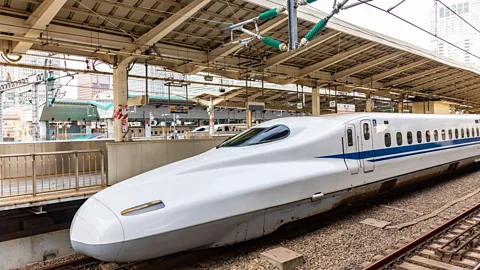How the bullet train transformed Japan
 Alamy
AlamySixty years after the world's first high-speed train launched, rail enthusiast Paul Carter rides the bullet train along what's been dubbed the "New Golden Route".
Standing on platform 19 at Tokyo Station, a bustling cathedral to modern rail travel, it's hard to believe that it was 60 years ago this year that the first Shinkansen train departed from here, bound for the port city of Osaka.
Instantly recognisable for its striking, sloping nose and sweeping aerodynamic curves, the Shinkansen was the world's first high-speed train and quickly became known around the world by its English-language moniker: the bullet train.
That high-speed line between Tokyo and Osaka – the Tokaido Shinkansen – became known by travellers as "The Golden Route", whisking passengers between two of Japan's great cities as it passed by the splendour of Mount Fuji and the ancient capital of Kyoto in less than two and a half hours.
 Alamy
AlamyAmidst the crowds of people boarding and alighting Shinkansen trains (which are known for their to-the-minute precision), I met with Naoyuki Ueno, a former Shinkansen driver who is now a senior executive at Central Japan Railway Company. He told me that since the train's introduction, it has carried a staggering 6.8 billion passengers across Japan.
"I'm proud of the Shinkansen," he said. "As a Japanese citizen I'm proud of that."
TRAIN JOURNEYS
Train Journeys is a BBC Travel series that celebrates the world's most interesting train rides and inspires readers to travel overland.
Since that first route opened in 1964, the Shinkansen network has expanded greatly, making it much easier (and quicker) for travellers to explore the nation's dramatic landscapes and far-flung cities. There are now nine Shinkansen lines across the country, covering the islands of Hokkaido, Honshu and Kyushu.
In March 2024, the most recent extension to the Hokuriku Shinkansen line opened, connecting the route to Tsuruga. The Hokuriku line has been dubbed "The New Golden Route", and it formed the basis of my journey from Tokyo to Osaka as part of the BBC series The World's Greatest Train Journeys. I used the Shinkansen as the backbone of my journey, but also connected with other local services and lines. Part of the brilliance of the bullet train is that it can whisk you out of a city in what feels like no time at all, giving you the freedom to quickly explore off-the-beaten-path corners of Japan.
Stepping off the Shinkansen in Toyama, just two hours from Tokyo, I took a small single-line train to the stunning resort town of Unazuki Onsen. Famous for its traditional Japanese hot springs (onsen) and nestled in the breathtaking surroundings of the Kurobe Gorge, it felt a million miles from the frenetic pace of the Tokyo metropolis. The springs are so synonymous with this town that there is even a hot foot spa at the end of the train station's platform.
My guide, Hashimoto Yukinori, or "Yuki", invited me to one of his favourite onsen in the town, with sweeping views across the valley. He explained to me that, traditionally, onsen are normally taken naked and communally. (Thankfully, for the sake of the global television audience, we were given special permission to wear swimsuits, something that would usually not be allowed.) Relaxing as they are, onsen aren't for the faint-hearted: the water was around 40C, and Yuki said sometimes they can be hotter.
"In Japan, we have lots of active volcanoes, so there [are many] hot springs all over Japan. It's really relaxing and kind of healing," he said. "Nature is very important for Japanese because we [have] mountainous islands. [We have] a lot of volcanoes and… many disasters. So, we have [a] fear of nature and also respect for nature."
The jewel in Unazuki Onsen's crown though – at least for train lovers like me – is the Kurobe Gorge Railway, a narrow-gauge line initially built to serve the construction of the huge Kurobe Dam. Set in a forested ravine and traversing 20km of truly sublime scenery, it's the perfect opportunity to connect with the natural environment.
Stepping back on the Shinkansen, I then headed to a city historically known for its samurai and gold: Kanazawa. Famed for producing 99% of Japan's gold leaf, Kanazawa is a city where old and new co-exist, yet it somehow manages to feel bustling and vibrant as well as surprisingly calm. After sampling some decadent gold leaf-covered ice cream, it was time to get back on the train.
My next stop after Kanazawa was the city of Wajima in the Noto peninsula, an area recently affected by disaster. On New Year's Day 2024, a 7.6-magnitude earthquake devastated the city and much of the surrounding area. Because of the damage, it's not currently possible to reach the city by rail. Instead, the journey involved a small local train to the town of Anamizu and then a quick drive to Wajima.
However, what pulled into the station was no ordinary train; it had Pokemon-themed carriages adorned in brightly coloured characters from the popular Japanese cartoon, including Pikachu and Bulbasaur. I later discovered that this train had been introduced to bring joy to local children who had suffered in the earthquake's aftermath.
Seeing Wajima was a sobering, humbling experience. Many of the buildings remain where they fell, often in a state of partial collapse. It was like walking along the set of a disaster movie, although this was all too real, with real people left behind to rebuild and repair. I'd come to see one of the area's oldest and most traditional crafts – Wajima-nuri (traditional Wajima lacquerware). The people here see rebuilding the lacquerware industry as intrinsic to the wider restoration of their culture and way of life.
 Getty Images
Getty ImagesTakahiro Taya, a tenth-generation lacquerware producer in Wajima told me, "If, the quake broke our industry, many people would lose their job. So, I should rebuild this industry for their craftsmen, of course, and for their customers. And I have a son. He's two years and eight months. I would like to give this job to my son."
I had one last ride on the Shinkansen to complete my journey to Osaka, Japan's second city. As I left rural Japan behind and headed back into the nation's urban sprawl, I thought about how much Japan has changed in the last 60 years. Today, it's a nation filled with ultra-modern cities and cutting-edge innovation, yet its people take great pride in their ancient traditions and rural roots. In a way, the Shinkansen, which connects the country's dense metropolises and its far-flung corners, is symbolic of Japan as a whole: a nation that's both reaching towards the future while also clinging to its past.
Japan is a country with much to explore, and with incredible extremes and contrasts. The Shinkansen has transformed the nation by making it possible to reach its remote corners in a surprisingly short amount of time. Yes, high-speed rail is all about getting from one place to another in the shortest possible time. But it also offers so much more than that. It provides an opportunity to step off, to take in the surroundings and to truly get off the beaten track. Happy birthday Shinkansen. Here's to the next 60 years.
--
If you liked this story, sign up for The Essential List newsletter – a handpicked selection of features, videos and can't-miss news, delivered to your inbox twice a week.
